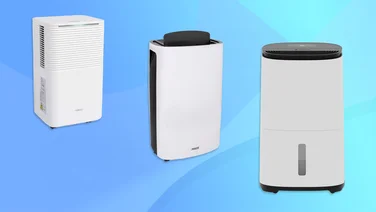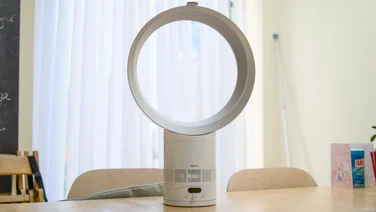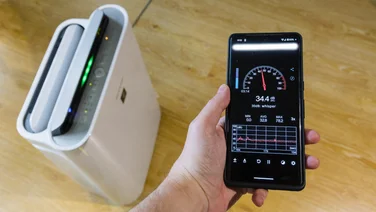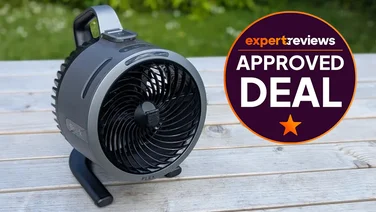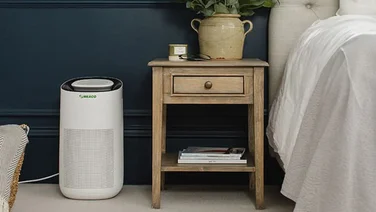To help us provide you with free impartial advice, we may earn a commission if you buy through links on our site. Learn more










- Quiet and powerful
- App control is useful
- Humidifies and purifies effectively
- Very expensive
- Only oscillates 90°
Dyson’s Humidify and Cool sits at the very top of Dyson’s range of exotic tower fans. It’s bigger and more expensive than the last Dyson fan we tested, the Pure Hot and Cool; instead of offering a heating function, however, the Dyson Humidify and Cool aims to boost the humidity of the air.
Of course, humidifying isn’t the Dyson Humidify and Cool’s only party trick. As with most of Dyson’s recent fans, it also provides air purification – useful for sufferers of hayfever – and a fan function for when you need cooling down on hot days.
What do you get for the money?
The Dyson Humidify and Cool is one expensive product, clocking in at a hefty £600, so you’d quite rightly expect a lot for your money. Thankfully the Humidify and Cool certainly feels like a premium product.
It’s very large and heavy, especially when the tank in the base is filled with water, and it looks the bee’s knees. Dyson’s trademark elongated fan “ring” sits on top of a silver, perforated base (this is where the air is drawn through the fan’s air filters and up into the fan head). Below that is the water tank, which is transparent so you can see when the water level is low. It all looks very swish indeed.
Although it looks very much like other Dyson fans, however, it works in a slightly different way: air is forced out of two vertical slots at the front of the fan head instead of a vent that completely surrounds the ring. Also, those apertures sweep left and right to distribute air around your room, instead of the whole head of the fan rotating as it does on the Pure Hot and Cool and others. This means you only get a 90-degree oscillation instead of a wider sweep. It’s good enough for most spaces, though.










As you’d expect, the Dyson Pure Humidify and Cool comes with all the luxuries you’d demand of a modern smart appliance costing upwards of £500. All functions are controlled by either a small silver remote control, which attaches magnetically to the top of the fan, or via the accompanying smartphone app, which connects to the fan over your home Wi-Fi network.
This app also allows you to monitor air quality remotely, either over your home network or when you’re out and about, and also allows you to set the machine to come on and off to a schedule.










You can also look at the various air quality, temperature and humidity statuses via a small circular display on the front of the fan, for those times when you can’t be bothered to get out your phone and fire up the app.
How effective is it?
For the purposes of this review, I compared the Humidify and Cool side by side with a Dyson Pure Hot and Cool and, in most situations I found the Humidify to be more effective. The fan pumps out a stronger gust of air at maximum settings and that air feels cooler on the skin, thanks to the biostatic evaporator used to humidify the air.
To test, I used an anemometer to measure both fans: at one metre away, the Humidify peaked at 3m/sec, while the Pure Hot and Cool reached only 2.1m/sec. That’s a pretty conclusive win for the bigger fan.










The sound the Pure Humidify and Cool produces is pretty low level, too. Sure, at max there’s quite a whooshing sound – it’s around 62-63dBA at a metre away versus the Hot and Cool at around 58-59dBA – but that drops at lower levels quite significantly, to around 45dBA at fan level 5.
The air purification system works nicely, too. To test this I sprayed some antiperspirant into a small room with the fan working at maximum click and monitored the air quality with a Foobot monitor. This raised the amount of particulate matter in the atmosphere to 68μm3 and the fan brought it down to the threshold safety level of 25μm3 in 10 minutes (a rate of 4.3μm3/min, as measured by my Foobot air monitor).










As a control, I ran the same test with the Pure Hot and Cool, which reduced the particulate matter from 62μm3 to 25μm3 in 9 minutes at a rate of 3.7μm3, and with a fan without air purification, which reduced it at a rate of 2μm3. The Humidify and Cool is faster than either, but not by a huge amount.
READ NEXT: The best fans to buy for all types of spaces
What about the humidifier?
The efficacy of the humidification aspect is trickier to quantify. The first question to address is whether humidity matters in the first place. A number of benefits are typically cited for humidifiers, the main ones being that they can keep your skin moisturised and that they reduce the likelihood of infection of flu or other seasonal diseases. The latter being a particularly important concern right now.
This article references several studies that suggest humidity can be associated with improved skin moisture and elasticity but that the benefits for skin health are inconclusive. Perhaps surprisingly, however, there’s a stronger cohort of supporting scientific opinion for the benefits of a humidifier when it comes to picking up infectious diseases.










More than one study has found that dry air can indeed increase the risk of viral infections (see the studies here and here). Some, indeed, have found that the presence of a humidifier could be a possible protective factor in reducing the risk of viral infection. Then again, over-humid air (higher than 60% relative humidity) can also increase your susceptibility, so you need to be careful.
The next questions to ask, then, are whether you need to raise humidity in the first place and whether the Dyson works to raise humidity. If the humidity in your room is between 40% and 50%, you don’t need to do anything since that’s the recommended level. (Note that figures refer to relative humidity, a number that falls when the ambient temperature rises, and rises as ambient temperature falls.)










To test how effective it was I ran it at max (set to its highest target 70% humidity) and saw humidity in my small office rise from 43.2% to 60.5% in 1hr 34mins. It was still rising when I turned it off and I saw humidity drop immediately and dramatically, falling to 48.1% 1hr 26mins after that.
It clearly works, then, although it’s worth bearing in mind that these tests weren’t carried out in scientifically controlled conditions and that results in other environments, at warmer or cooler temperatures and at different altitudes may differ.
Is there anything else I should know about?
Don’t forget that you’ll need to periodically replace the air purification filters. Dyson recommends you replace these once a year but the fan will alert you so there’s no need to worry about forgetting. These cost around £50 a set.
You do not, however, need to replace the water filter because the Dyson doesn’t use one. Instead, it uses a strong UV light to clean the water that’s used to humidify the air. You do need to keep the system clean but this is as simple as running a deep clean cycle using water and citric acid this is recommended.










Dyson Pure Humidify and Cool: Should I buy one?
The Dyson Humidify and Cool is certainly an elegant appliance and one that works effectively. It’s quiet and the impressive amount of air it shifts does feel cooler on the skin than air from a regular fan. The Humidifier works, too, as does the air purification aspect.
But another thing is clear: at £600, the Pure Humidify and Cool is also very, very expensive. In fact, for the same price as this fan, you could buy yourself an air conditioning unit that will cool the air as well as circulate it, a separate humidifier so you can put back some of the moisture that the aircon unit removes and a separate air purification system.
The benefit of the Dyson is that it combines a lot of the features of those devices in one elegant package; you just have to decide whether it’s worth the extra investment.


